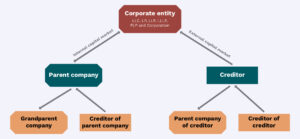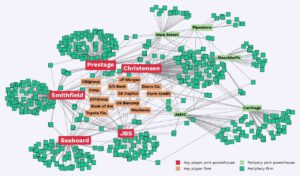February 18, 2023
#5: Sorting out Ownership Questions – The Ultimately Unclear Beneficiaries of Power in Industrial Agriculture
Who or what are the ultimate beneficiaries of power in industrial agriculture? This is one of the key questions we tackle with our new theme on “Sorting out Ownership Questions – Methodological Challenges”.
Sociologists Loka Ashwood and Phil Howard have taken up the difficult task and write about the problem of tracing ownership relations along the agri-investment chain. The territorialized ownership question (who owns which land) and the relational ownership question are entangled in complex ways, and raise further questions about the governance of agri-investment chains, transparency of land and capital markets, internal and external credit markets, and taxation. Their contribution makes a broader call, to look at ownership relations beyond land, thus resonating with the approach of our institutional landscapes project that the entanglements of global finance and food/agriculture need to be discussed “beyond” land (even though land is a key aspect to focus on).
***
Who really are the ultimate beneficiaries of the highly consolidated, exclusive, and intensive system of agriculture that increasingly dominates the globe?We, as scholars, have become particularly good at identifying who isn’t.
We know it’s not the climate. Our global surface temperatures are continuously rising, with 2022 being the 6th warmest year on record [1]. The blame primarily falls on carbon dioxide emissions from fossil fuel use. And industrial-scale agriculture uses a lot of fuel, from mining nutrients, to manufacturing chemicals, to transporting fruits from distant fields to large urban centres.
We know it’s not the farmers. Scaling up pushes out locally rooted and community-based farms. The decimation of U.S. hog farmers is a particularly acute example, where since 1978, nearly nine out of ten have gone out of business. It’s been nearly as bad for dairy farms, with an 82% loss. U.S. row-crop farms likewise have suffered, with seven out of every ten wheat farmers and six out of every ten corn farmers having gone out of business since the late seventies [2].
We know it’s not rural communities. They have suffered alongside the farmers pushed off the land. In the United States’ Midwest, sometimes called the heartland, the loss of farmers has been acute. Likewise, from 1980 to 2020, the poverty rates have increased in thirty-three percent of rural counties in the Midwest [3].
We know it is not good for the agricultural workers in the field and on the line. Rather than “farmers”, “workers” capture a fundamental shift of power in agriculture, where those who labour no longer have rights to ownership, profit, and their own means of production and reproduction. They continue to work cruelly long hours, subject to the highest of temperatures when climate emergency events like heat waves hit. In the U.S., the highest rates of disease contraction and deaths during the COVID-19 pandemic occurred at processing facilities, where workers – largely people of colour and immigrants – were forced to stay on the line [4].
We know it’s not good for the animals. When the doors finally shuttered at processing plants during the pandemic, the concentrated animal feeding operations (CAFOs) fattening thousands of pigs before the slaughter had no place to move the animals, or the financial incentive to continue feeding them, as shipments of piglets continued to arrive at the confinement door. Operators euthanised them, sometimes by turning off the ventilation, with subsidisation from the U.S. government. The pigs were left to breathe in deathly amounts of dank ammonia from their own feces [5][6].
And we know that the general eater has not benefited. A highly bureaucratic and centralised food system has lost its nimbleness, vulnerable to crises—however brief—but catastrophic [7]. The largest companies have reaped the rewards. Beef, pork, and chicken prices have all reached record highs in recent months in the U.S., for example, with the top four firms controlling 54 to more than 80 percent of these sectors. These increases occurred after the leading firms—including JBS, Tyson, Cargill, and WH Group’s Smithfield— were hit with hundreds of millions of dollars in fines and settlements for using a data sharing service to coordinate their actions to drive up prices.
But we know markedly less about the few who ultimately benefit from these firms’ global dominance in food and agriculture. Courts of law sometimes provide brief glimpses into oligarchs’ holdings, such as the disclosure of Bill Gates’ and his wife Melinda’s farmland investments during their divorce proceedings. Yet these crucial insights remain rare and scattered. We consider here a series of practical and theoretical opportunities to better capture how power works and who, as well as what, has it in food and agriculture.
More Attention to Power in Food and Agriculture
Most approaches to the study of food and agriculture devote little attention to power. Economics, for example, sometimes examines control over prices or outputs, but ignores other sources of power used by large organisations. Power is difficult to define, however, let alone measure. One succinct definition is “the capacity of some persons to produce intended and foreseen effects on others” [8]. This describes “power over,” but not “power to” or the ability to gain control, particularly by creating new opportunities [9].Nitzan and Bichler’s theory of “capital as power” focuses on “power over” – which can include domination or constraint, although it also recognises resistance and “power to” [10]. Their approach provides tools to measure “power over” from the perspective of capitalists: the dominant actors in our political economy. For example, they view the market capitalisation figures of publicly traded firms to be consensus estimates of a future stream of earnings in present values, discounted for risk. This measures investors’ expectations that the firm’s owners and directors will continue to successfully shape and reshape society to their benefit, relative to other dominant firms. The qualitative strategies that firms employ are analysed for their impacts on quantitative measures of power, like relationships between agricultural input firms and grain traders [11]. Key strategies include maintaining government subsidies for grains and oilseeds, as well as promoting the wasteful use of these foods as biofuels, which dramatically increased their market capitalisation in the early 2000s.
Much more research from a capital as power perspective is needed. Some promising directions include a focus on the networks and property relations that key players in food and agricultural industries employ and assessing “power to” strategies of those who are not benefitting from the current system [12][13].
More on the Corporate-finance Network
Financialisation stormed critical agrarian studies, bringing with it calls to pay closer attention to new financial vehicles of investment and the burgeoning pension and hedge funds grabbing up land to diversify their portfolios. But nailing the power dynamics of these relations requires precise data on their structure. The lack of data about financial investment goes some way in explaining the gap between research on corporate agriculture and finance. Critiques of corporate agriculture typically draw on tax parcel data alongside broader material and historical trends, but this owner-centric focus often has overlooked the crucial role of finance [14].
Corporate finance plays a crucial role in shaping power and beneficiaries, and transforming the meaning of ownership. Redrawn from: Ashwood, Canfield, Fairbairn and De Master 2022.
Financialisation research, on the other hand, is disproportionately theoretical in part due to the lack of access to data that elucidates the full extent of private firms’ power within public multilayered subsidiary companies. Network approaches—flexible in their flows but precise in their nodes—help rethink land holdings and corporate power. It moves away from understanding ownership flatly, and instead takes a more multidimensional approach. Terms like corporate finance, and methods like social network analysis, can help scholars get there [15].

Social Network Analysis can help identify key players in agricultural sectors and the financial entities supporting them, for example, pork. Redrawn from: Ashwood, Pilny, Canfield, Jamila, and Tompson 2022.
Bring Power to the Study of Markets and Property
Less dogmatic approaches to property and markets can help identify the minutiae that mean the difference between systemic collapse in agriculture and democratic distribution. Polanyi’s condemnation of the marketisation of society provides a canonical understanding of how the state creates markets; but it also demonstrates how markets can thus be changed to serve different ends [16]. Those ends can potentially be more affable ones for communities, with particular care to avoid debt-peonage relations [17]. Careful thinking about different forms of property can better enable certain forms of access than others, for example nuisance protections, which can be a last recourse to keep polluting industries accountable when the regulatory state fails them. Further, it recognises the landownership ethic that informs the culture of the rural U.S. [18]. This enables praxis: the design and utilisation of theory that promotes the action necessary to transform power in agriculture. Focusing on markets and forms of different forms of access ownership (like collective commonage or proprietary farms) most conducive to distributive, justice-based, and distributive ends is the ultimate challenge for critical agrarian work.[1] National Oceanic and Atmospheric Administration (2023) 2022 was world’s 6th-warmest year on record. Available at: https://www.noaa.gov/news/2022-was-worlds-6th-warmest-year-on-record (accessed: 18/01/2023). [2] Ashwood L, Aimee I, Lindsay K, et al. (Forthcoming) Empty Fields, Empty Promises: A Guide to Understanding and Transforming the Right to Farm. Chapel Hill: University of North Carolina Press. [3] Ibid. [4] Carrillo IR and Ipsen A (2021) Worksites as Sacrifice Zones: Structural precarity and Covid-19 in US meatpacking. Sociological Perspectives 64(5): 726–746. [5] Marchant-Forde JN and Boyle LA (2020) COVID-19 effects on livestock production: A One Welfare issue. Frontiers in veterinary science 7: 585-787. [6] Saitone TL, Schaefer KA and Scheitrum DP (2021) COVID-19 morbidity and mortality in US meatpacking counties. Food Policy 101: 1-18. [7] Hendrickson M (2020) Covid lays bare the brittleness of a concentrated and consolidated food system. Agriculture and Human Values 37(3): 579-580. [8] Wrong DH (1995) Power: Its Forms, Bases, and Uses. New Brunswick, NJ: Transaction Publishers, p. 2. [9] Gaventa J (2020) Beyond the prepositions: using power analysis to inform strategies for social action. Sussex, UK: Institute of Development Studies. [10] Nitzan J and Bichler S (2009) Capital as Power: A Study of Order and Creorder. New York: Routledge. [11] Baines J (2014) Food price inflation as redistribution: towards a new analysis of corporate power in the world food system. New Political Economy 19(1): 79–112. [12] Howard PH (2021) Concentration and Power in the Food System: Who Controls What We Eat? Revised edition. London: Bloomsbury Academic. [13] Goldschmidt W (1978) As You Sow. Montclair, NJ: Allanheld, Osman and Co., Publishers Inc. [14] Gunnoe A, Bailey C and Ameyaw L (2018) Millions of acres, billions of trees: Socioecological impacts of shifting timberland ownership. Rural Sociology 83(4): 799-822. [15] Ashwood L, Pilny A, Canfield J, et al. (2022) From Big Ag to Big Finance: A Market Network Approach to Power in Agriculture. Agriculture and Human Values. 39(4): 1421-1434. [16] Polanyi K (1944) The Great Transformation. Boston, MA: Beacon Press. [17] Graeber D (2014) Debt: The First 5,000 Years. Brooklyn and London: Melville House. [18] Ashwood L (2018) For-Profit Democracy: Why the Government is Losing the Trust of Rural America. New Haven, CT: Yale University Press.